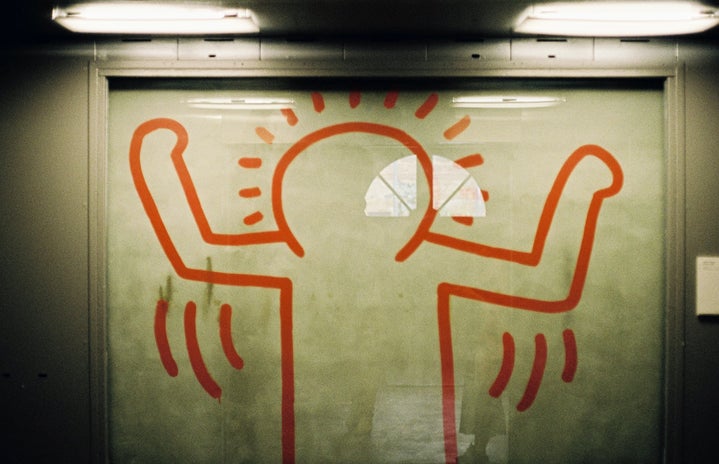What does it mean to be the voice of a generation? To Keith Haring, it meant having a responsibility to speak out against what was wrong and inspire others in the process.
Keith Haring was born in 1958 in Reading, Pennsylvania. As a young child, Haring was inspired by artists like Walt Disney and Dr. Seuss, and after learning about cartooning from his father, developed a love for art and drawing. In 1976, Haring enrolled in Pittsburgh’s Ivy School of Professional Art, but dropped out after only two semesters. Later that year, he moved to New York City and enrolled in the School of Visual Arts.
Despite working with several different mediums over the course of his academic career, Haring stayed dedicated to drawing and craved the ability to devote his career to creating “truly public art.” In 1980, he finally found a way to share his art with a wider public audience. After seeing unused advertising panels in subway stations, Haring began to create drawings in white chalk on the matte black paper that covered them, sometimes doing as many as 40 drawings in one day. Haring had already been doing exhibitions and performances throughout the city, but these “subway drawings” helped him become a familiar and recognizable part of the New York City art scene.
In the years that followed, Keith Haring became an international sensation. He participated in several group and solo exhibitions, created murals worldwide (including on the Berlin Wall), designed sets and backdrops for theatres and clubs, opened a retail store called the Pop Shop (dedicated to allowing people greater access to his work at a low cost), and worked on campaigns for brands like Swatch and Absolut Vodka. He was well-known around the city and forged friendships with people like Jean-Michel Basquiat, Andy Warhol, and Madonna.
Over the duration of his career, Haring devoted much of his time to public works that often carried social or political messages. Between 1982 and 1989, he created over 50 public works of art around the world for places like charities, hospitals, children’s daycare centers, and orphanages. He also often worked with children on his murals, held drawing workshops in schools and museums in cities around the world, and produced imagery for many literacy programs and other public service campaigns.
In 1988, Haring was diagnosed with Acquired Immune Deficiency Syndrome (AIDS), and in 1989 he established the Keith Haring Foundation, an organization dedicated to providing funding and imagery to AIDS organizations and children’s programs, and to expanding the audience for Haring’s work through exhibitions, publications, and the licensing of his images. He had always made it a priority to create art that addressed social issues (like Apartheid, homophobia, and New York’s growing crack epidemic), but in his final years, he focused primarily on art that addressed the AIDS epidemic, both promoting awareness and safe sex practices and condemning the government for their inaction regarding treating the illness. He donated tens of thousands of dollars to HIV/AIDS awareness organizations and was creating art like never before, celebrating life and burning the candle at both ends in an effort to put as much of himself out into the world as possible before his time was up.
Two years into his diagnosis, Haring laid out his life story and what it was like living with AIDS in a Rolling Stone article, to challenge the silence and stigma surrounding the illness. The choice was a brave, yet controversial one. AIDS had become an illness that was surrounded by hysteria and fear as it swept its way through New York. Thousands of people had it, but it wasn’t widely addressed, especially not by celebrities. Haring was praised by some for his candidness about the disease while also being shunned by several friends and acquaintances. Studio art major Natalie Lusk says that this is one of the things about Haring that inspires her the most. “I’m inspired by Haring’s dedication to helping his community through his work. His willingness to express intimate personal experiences as a means of uplifting himself and his community is something I strive to do as an artist.”
In 1990, Keith Haring died of AIDS-related complications. He was 31. Throughout his time in the art world, he carried out his devotion to making his art as public and accessible as possible and is estimated to have created over 10,000 pieces of art. His career burned fast and bright, but his legacy is one that will live on for generations to come.
Want to see more HCFSU? Be sure to like us on Facebook and follow us on Instagram, Twitter, TikTok, YouTube and Pinterest!


